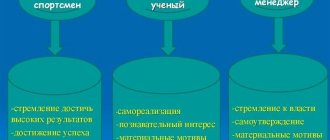Human needs are conditional, mobile, and virtual in nature. The virtuality of needs is that each of them contains its own other, a moment of self-negation. Due to the variety of conditions of implementation, age, environment, biological need becomes material, social or spiritual, i.e. transforms. In the parallelogram of needs (biological need - material - social - spiritual), the dominant need becomes the one that most corresponds to the personal meaning of a person’s life, is better equipped with the means of its satisfaction, i.e. the one who is better motivated.
The transition from need to activity is the process of changing the direction of need from within to the external environment. At the heart of any activity is a motive that encourages a person to do it, but not every activity can satisfy the motive. The mechanism of this transition includes: I) selection and motivation of the subject of need (motivation - justification of the subject to satisfy the need); 2) during the transition from need to activity, the need is transformed into purpose and interest (conscious need).
Thus, need and motivation are closely related: need stimulates a person to activity, and a component of activity is always motive.
Motive of man and personality
A motive is what motivates a person to act, directing him to satisfy a specific need. Motive is a reflection of need, which acts as an objective law, an objective necessity.
For example, the motive can be both hard work with inspiration and enthusiasm, and avoidance as a sign of protest.
Motives can be needs, thoughts, feelings and other mental formations. However, internal motivation is not enough to carry out activities. It is necessary to have an object of activity and correlate the motives with the goals that the individual wants to achieve as a result of the activity. In the motivational-target sphere, the social conditioning of activity appears with particular clarity.
By [[Motivational-need sphere of personality|need-motivational sphere of personality is meant the entire set of motives that are formed and develop during a person’s life. In general, this sphere is dynamic, but some motives are relatively stable and, subordinating other motives, form, as it were, the core of the entire sphere. These motives reveal the direction of the individual.
Motivation of a person and personality
Motivation is a set of internal and external driving forces that motivate a person to act in a specific, goal-directed manner; the process of motivating oneself and others to act to achieve organizational or personal goals.
The concept of “motivation” is broader than the concept of “motive”. Motive, in contrast to motivation, is something that belongs to the subject of behavior, is his stable personal property, which internally encourages him to perform certain actions. The concept of “motivation” has a double meaning: firstly, it is a system of factors influencing human behavior (needs, motives, goals, intentions, etc.), secondly, it is a characteristic of the process that stimulates and supports behavioral activity at a certain level. level.
In the motivational sphere, the following are distinguished:
- motivational system of a person is a general (holistic) organization of all the motivating forces of activity underlying human behavior, which includes such components as needs, actual motives, interests, drives, beliefs, goals, attitudes, stereotypes, norms, values, etc. .;
- achievement motivation - the need to achieve high behavioral results and satisfy all other needs;
- self-actualization motivation is the highest level in the hierarchy of personal motives, consisting of the individual’s need for the fullest realization of his potential, the need for self-realization.
Worthy goals, long-term plans, good organization will be ineffective if the interest of the performers in their implementation is not ensured, i.e. motivation. Motivation can compensate for many deficiencies in other functions, such as deficiencies in planning, but weak motivation is almost impossible to compensate for with anything.
Success in any activity depends not only on abilities and knowledge, but also on motivation (the desire to work and achieve high results). The higher the level of motivation and activity, the more factors (i.e. motives) prompt a person to activity, the more effort he is inclined to put in.
Highly motivated individuals work harder and tend to achieve better results in their activities. Motivation is one of the most important factors (along with abilities, knowledge, skills) that ensures success in activity.
It would be wrong to consider the motivational sphere of an individual only as a reflection of the totality of his own individual needs. The needs of the individual are related to the needs of society and are formed and developed in the context of their development. Some needs of an individual can be considered as individualized social needs. In the motivational sphere of a person, both his individual and social needs are reflected in one way or another. The form of reflection depends on the position the individual occupies in the system of social relations.
Motivation
Motivation is the process of influencing a person in order to encourage him to take certain actions by activating certain motives.
There are two main types of motivation:
- external influence on a person with the aim of inducing him to perform certain actions leading to a desired result. This type resembles a trade deal: “I give you what you want, and you satisfy my desire”;
- the formation of a certain motivational structure of a person as a type of motivation is educational in nature. Its implementation requires great effort, knowledge, and abilities, but the results exceed those of the first type of motivation.
General characteristics of a person’s motivational sphere
One of the most important concepts of motivational psychology is the concept of the “motivational sphere” of the individual (more precisely, the motivational system).
Motivation is a system of factors that determine human behavior; characteristic of a process that stimulates and maintains behavioral activity at a certain level.
In other words, motivation is a set of psychological reasons that cause an individual’s activity, determine its direction and explain human behavior. Motivation can be viewed as a cyclical process of continuous mutual action and transformation of the situation by the individual, the result of which is his actual observable behavior as a process of continuous choice and decision-making.
Motivation explains the purposefulness of actions, orderliness and sustainability of holistic activities to achieve a specific goal.
Like any other system, the human motivational world includes a certain set of its components, as well as regular and stable connections between them.
The main components of the motivational sphere of the individual are the following basic psychological formations and structures: needs, drives, attitudes, motives, interests, ideals, intentions, social norms and roles, stereotypes, etc.
All these components have a basic common feature: they have two main sides, two aspects - content and dynamic.
The content aspect consists in the representation of external - reflected - reality and usually appears in the form of certain knowledge.
The dynamic aspect is due to the fact that each of the listed components of the motivational sphere has a certain potential to initiate, maintain and change the activity of the subject. Based on this, all of the listed components are combined in the motivational sphere of the individual.
The motivational sphere of a person can be assessed in its development according to the following parameters:
1) Breadth is a parameter that reflects the diversity of motivational factors - motives, needs and goals. The more motives, needs, and goals a person has, the more developed his motivational sphere is;
2) Flexibility - the area of motivation is more flexible, where more motivational stimuli are used to satisfy needs (for example, one person learns only from TV, and another from books, TV, newspapers);
3) Hierarchization - the greater the differences in the strength and frequency of actualization of motivational formations at a given level, the higher the hierarchization of the motivational sphere.
There are the following 2 types of motivation:
1) Situational motivation - includes motivating factors that force a person to act from the external environment. These factors include certain situational characteristics, actions and actions of surrounding people, culture, social position occupied by a person, etc.;
2) Dispositional motivation - a person’s internal motivation.
It includes a goal - a conscious idea of the expected result towards which a person’s actions are aimed. The basis for the formation of a person’s goals is his subjective-material labor activity aimed at transforming the external world. The process of setting and achieving goals includes the following steps:
a) formation of gates;
b) taking actions to achieve the goal;
c) emotional and cognitive (cognitive) assessment of the course of actions and their final result.
The image of the expected result acquires a motivating force, becomes a goal, begins to guide action and determine the choice of possible ways to realize the goal. The formation of a goal, the emergence of a goal, is a central moment in the process of implementing an action and the main mechanism for the formation of new human actions. The psychophysiological basis of the goal is the “picture of the required future” encoded in the brain (N.A. Bernstein), an acceptor of the results of action (P.K. Anokhin), which regulates the program of physiological execution of the action with the help of anticipatory and authoritarian (providing information about the correspondence of the achieved result to the desired ) commands.
Needs
One of the main sources of human activity is needs. Need expresses a person’s dependence on certain conditions of existence. The specificity of human needs is determined by the social nature of human activity, especially labor.
Need is a state of a person that arises in conditions of need for objects necessary for his existence and development, and serves as a source of his activity.
In this context, the process of satisfying a need acts as an active, purposeful process of a person’s coping with a form of activity that is determined by the level of social development. Human needs have a social and personal nature, which is expressed in the fact that to satisfy needs a person uses those methods and techniques that have historically developed in a given social environment and are necessary under certain conditions.
Needs may take a different form.
For example, they may be perceived differently by people. In this case they take the form of attraction. This is an incentive to activity, which is an undifferentiated, insufficiently realized need.
Attraction is the primary emotional manifestation of a human need for something, a motivation not yet mediated by conscious goal setting. In Russian psychology, attraction is considered as a stage in the formation of a motive for behavior, that is, it acts as a transitory phenomenon: the need presented in it either passes or is realized in the form of a specific desire. Thus, attractions are determined not only by biological, but also by social factors. Moreover, in home economics the prevailing opinion is that in a person with developed consciousness, drives do not play the main role as motives of behavior, but serve as “building material” for conscious motives. On the other hand, drive is one of the central concepts of psychoanalysis, which gives it a leading role in the activity and regulation of human behavior.
Another unconscious impulse is attitude. This is an unconscious state of a person’s readiness for a certain form of activity.
This may be readiness for activity, for behavior, for understanding or interpreting something. Attitudes manifested in the interpretation of events, phenomena and facts can take the form of prejudices or stereotypes.
Attitudes usually develop as a result of repeated situations in which a person reacts in a certain way.
D.N. Uznadze developed a theory according to which the needs and situations that arise during a meeting determine the direction of the subject's behavior until the behavior encounters certain obstacles. In these cases, unconscious behavior is interrupted and conscious mechanisms of objectification come into play. Obstacles that arise are noticed and realized. After consciously finding a new way of regulation, control over behavior is again exercised through unconscious attitudes. This continuous transfer of control ensures a harmonious and more economical interaction between the conscious and unconscious.
Classification of needs
In the history of psychology, there have been attempts to reduce all human needs to one - primary and basic (in the works of Freud and Adler these are libido and the “desire for power”, respectively).
At the same time, Murray's classification of needs includes more than 140 human needs.
Thomas asked himself in 1924: what are the minimum human needs? In response to his question, he listed 4: the need for security, recognition, friendship, new experiences (his answer was based on a study of prostitution among young people).
J. Peter (1938) argued that throughout human history the most frequently competing needs were: Food, freedom, sexual partners, faith (beliefs, ideals).
Social motivation
Every person is part of society, so social motivation is an integral component that influences his behavior. Social needs come in third place after natural and material needs. Naturally, material benefits cannot be placed below simple social approval. But it is very important for a person to feel part of society, to receive signs of respect and praise from other people.
Social motivation is an important tool for managing people. Managers use it to improve work efficiency. For example, a person who has been praised will strive to improve his skills in order to gain approval from his superiors. Many organizations have an honor board on which photographs of the best employees are posted. This is done to show what others should strive for. A good motivating method is also to present some kind of insignia in front of the whole team. Today, it is not at all necessary to gather all employees in the assembly hall in order to publicly pay tribute to a distinguished employee. It is enough to simply send out a general email.
Motives and motivational systems
Motive (from Latin movere - “to set in motion, push”) is:
1) a factor that motivates a person to activity and is associated with meeting the needs of the subject; a set of external or internal conditions that cause the subject’s activity and determine its direction;
2) a certain object (material or ideal) that motivates a person to activity and determines its direction
3) the conscious reason underlying a person’s choice of actions and actions
4) what belongs to the subject of behavior himself is his stable personal property, from which he is motivated to perform certain actions;
5) psychological states that characterize a person’s private, changeable attitude towards objects or phenomena of the surrounding reality.
The mechanism for the emergence of motives is the realization of needs in the course of addictive activity, and therefore the transformation of the objects of this activity into motives. Hence the central law follows: the development of motives occurs through a change and expansion of the scope of activity, which changes objective reality.
Motives differ from each other in the type of needs they manifest; the forms they take; breadth or narrowness, the specific content of the activity in which they are implemented. Any human activity is motivated not by one motive, but by several, that is, the activity is usually multimotivated.
The set of stable motives that determine the selectivity of a person’s attitudes and actions and are relatively independent of existing situations is called the orientation of the individual. Personality as a substructure of personality includes various motives: their motivations, needs, inclinations, interests, aspirations, intentions, ideals, norms, self-esteem, assessment of others, level of aspiration, attitudes, etc. Some of its components are dominant, others play a subordinate role.
In complex activities, there is usually not one, but several simultaneously acting and interacting motives.
Motives can be conscious or unconscious.
The following functions of motives are distinguished:
1) motivating;
2) directing;
3) meaning-forming function, which consists of motives that give personal meaning to reality reflected in the individual consciousness;
4) the function of controlling the direction of human activity - this function is performed by motives not directly, but through the mechanism of “emotional correction” of behavior (A.V. Zaporozhets). This “emotional correction” of behavior occurs as follows: With the help of emotions, a person evaluates the personal meaning of current events and, if this meaning does not coincide with his own motives, changes the general direction of his activities.
Leontiev identifies mainly two functions of motives: Motivation and comprehension. Sense-forming motives give personal meaning to an activity, while other motives accompanying it serve as stimuli (positive or negative) - sometimes acutely emotional, affective, without a meaning-forming function. These are motives and motivations. Here the difference between the two types of motives is relative. In a hierarchical structure, one specific motive may serve as a meaning-making function, while another may serve as an additional stimulus. The merging of two functions of motivation, motivation and meaning formation, gives human activity the character of a consciously regulated activity. When the meaning-forming function of a motive decreases, it can only become understandable. Conversely, when a motive becomes “simply understandable,” we can say that its meaning-forming function has weakened.
X. Heckhausen considers the function of motive only in connection with the stages of action - initiation, execution, completion. At the initial stage, the motive initiates, stimulates, encourages action. The implementation of the motive at the execution stage ensures a constant high level of action activity. Maintaining motivation at the stage of completing an action is associated with evaluating results and success, which helps reinforce motives.
Many of the motivational factors become so characteristic of a person over time that they turn into personality traits. These include the motive for achieving success, the motive for avoiding failure, and anxiety. In addition, the need for communication (affiliation), the power motive, the auxiliary motive and aggressiveness characterize a person personally.
Diagnostics
Diagnosis of the motivational sphere helps to determine the direction of the individual and identify the true reasons for actions .
The orientation of a person is the sum of motives that are stable and independent of external conditions.
Test of humorous phrases (TUF)
The technique is based on the principle of thematic classification . The person undergoing the test assigns ambiguous stimuli a place in the individual classification, guided by apperception.










